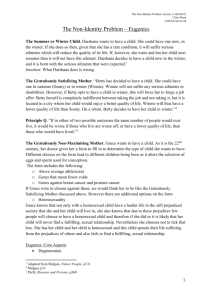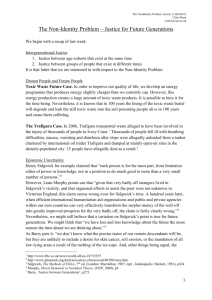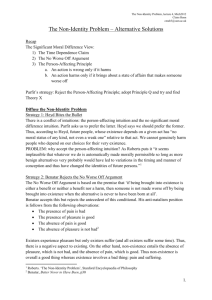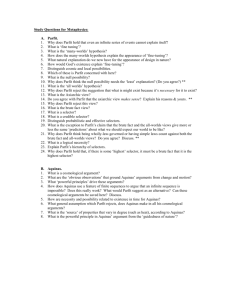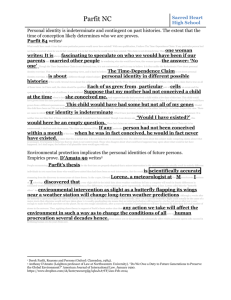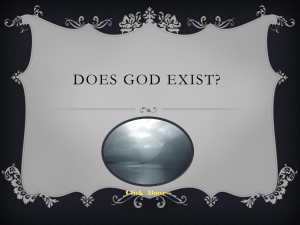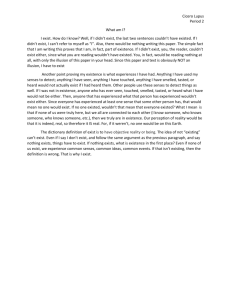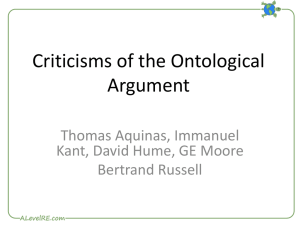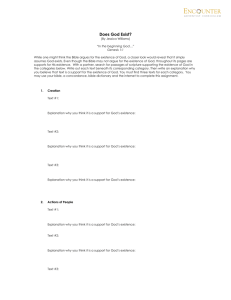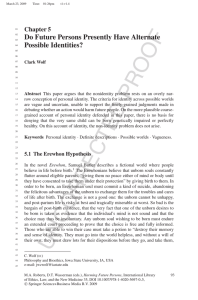The Non-Identity Problem Lecture Notes
advertisement
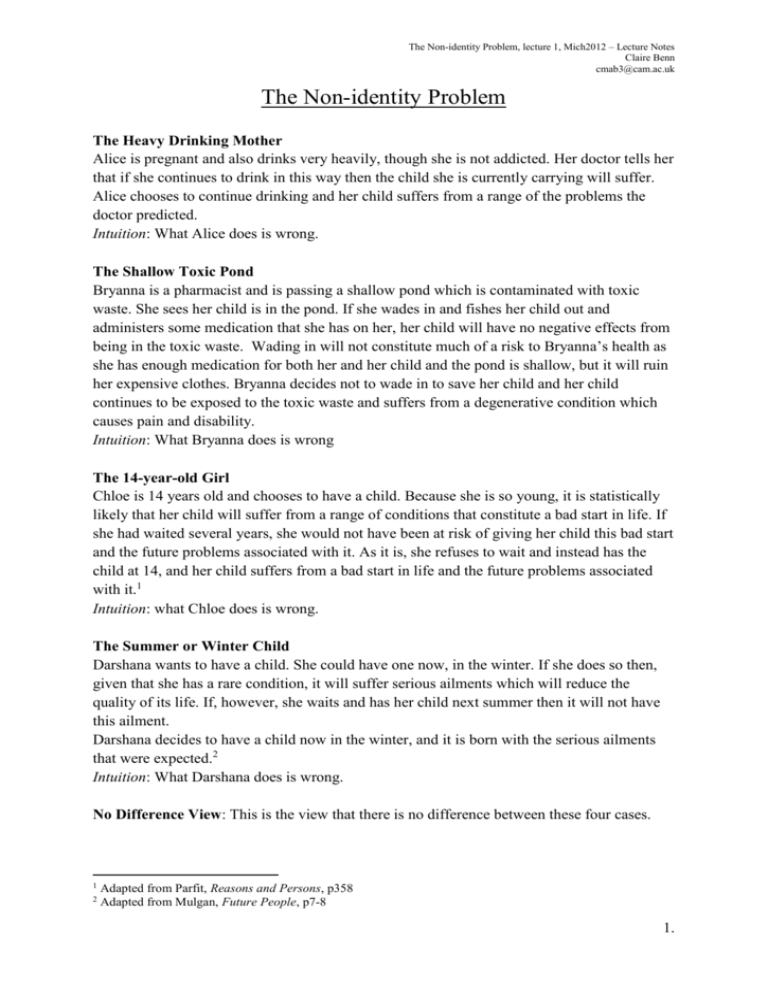
The Non-identity Problem, lecture 1, Mich2012 – Lecture Notes Claire Benn cmab3@cam.ac.uk The Non-identity Problem The Heavy Drinking Mother Alice is pregnant and also drinks very heavily, though she is not addicted. Her doctor tells her that if she continues to drink in this way then the child she is currently carrying will suffer. Alice chooses to continue drinking and her child suffers from a range of the problems the doctor predicted. Intuition: What Alice does is wrong. The Shallow Toxic Pond Bryanna is a pharmacist and is passing a shallow pond which is contaminated with toxic waste. She sees her child is in the pond. If she wades in and fishes her child out and administers some medication that she has on her, her child will have no negative effects from being in the toxic waste. Wading in will not constitute much of a risk to Bryanna’s health as she has enough medication for both her and her child and the pond is shallow, but it will ruin her expensive clothes. Bryanna decides not to wade in to save her child and her child continues to be exposed to the toxic waste and suffers from a degenerative condition which causes pain and disability. Intuition: What Bryanna does is wrong The 14-year-old Girl Chloe is 14 years old and chooses to have a child. Because she is so young, it is statistically likely that her child will suffer from a range of conditions that constitute a bad start in life. If she had waited several years, she would not have been at risk of giving her child this bad start and the future problems associated with it. As it is, she refuses to wait and instead has the child at 14, and her child suffers from a bad start in life and the future problems associated with it.1 Intuition: what Chloe does is wrong. The Summer or Winter Child Darshana wants to have a child. She could have one now, in the winter. If she does so then, given that she has a rare condition, it will suffer serious ailments which will reduce the quality of its life. If, however, she waits and has her child next summer then it will not have this ailment. Darshana decides to have a child now in the winter, and it is born with the serious ailments that were expected.2 Intuition: What Darshana does is wrong. No Difference View: This is the view that there is no difference between these four cases. 1 2 Adapted from Parfit, Reasons and Persons, p358 Adapted from Mulgan, Future People, p7-8 1. The Non-identity Problem, lecture 1, Mich2012 – Lecture Notes Claire Benn cmab3@cam.ac.uk Identity Time-Dependence Claim (TD1): “If any particular person had not been conceived when he [or she] was in fact conceived, it is in fact true that he [or she] would never have existed.”3 Modified Time-Dependence Claim (TD2): “If any particular person had not been conceived within a month of the time when he [or she] was in fact conceived, he [or she] would in fact never have existed.”4 Same People Choices and Different People Choices Parfit claims that we should ask ourselves the following question: “Would all and only the same people ever live in both outcomes?”5 If we answer ‘Yes’, then we are faced with what he class a Same Person Choice. If we answer ‘No’, then we are faced with Different Person Choice. Thus the first two cases are Same Person Choices. Chloe and Darshana face Different Person Choices. Is this a significant moral difference? The Person-Affecting Principle Basic idea: for an action to be bad it has to be bad for someone. The Person-Affecting Principle. “An action can be wrong only if there exists some particular person who is worse off after that action than they would have been if some other action had been performed instead.”6 Key features: 1. For an action to be wrong, it must involve a harm. 2. For an action to be considered harmful it must leave someone worse off. 3. The notion of harm, and therefore wrong, is comparative. 4. Not only is it comparative, but the comparison is a counterfactual one. Non-Existence and Wrongful Life and Wrongful Disability Is it possible to claim that non-existence is preferable to existence? As Buchanan et al. point out, this is problematic because “non-existence is not any kind of condition, so it is clearly not a condition that could be better for the infant than the existence it has. When the alternative is nonexistence, there is no individual who is made worse off by being conceived and born.”7 3 Parfit, Reasons and Persons, p351, original italics Parfit, Reasons and Persons, p352 5 Parfit, Reasons and Persons, p356 6 Mulgan, Future People, p9 7 Buchanan et al., From Chance to Choice, p234 4 2. The Non-identity Problem, lecture 1, Mich2012 – Lecture Notes Claire Benn cmab3@cam.ac.uk However, consider the following case: The Selfish Parents. “Jane and Jim are a new age couple, keen to explore their own capacity for self-awareness and compassion. Although they could conceive a perfectly healthy child, they choose to have a child with a very severe disability, as this will provide them with a range of new emotional experiences. Suppose their child will suffer from Tay-Sachs disease, whose usual course is as follows. The child appears well at birth and develops normally for six to eight months when progressive psychomotor degeneration slowly begins. By eighteen months the child is likely to be paralysed and blind, unable to take food by mouth, suffering from constipation and decubitus ulcers. There are increasingly frequent convulsions which cannot be controlled by medication. The last few years of the child's life are usually spent in a vegetative state.”8 The Basic Wrongness Intuition. “It is wrong gratuitously to create a child whose life contains nothing but suffering.”9 Thus we can compare existence to non-existence and claim that non-existence can be preferable and existence can be a wrong even when the only alternative is non-existence. Great! Problem solved! Hang on a second though…. We need to distinguish cases of: a) Wrongful life: “cases in which the […] disease or condition is so severe as to make the individual’s life from that individual’s perspective not worth living”10 b) Wrongful disability: where “an individual has a significant […] disability, but one that is not so serious as to make life not worthwhile.”11 What makes these disabilities intuitively ‘wrongful’ is that “The disability could have been prevented by the child’s mother, but only by conceiving at a different time and/or under different conditions.”12 The No Worse-Off Argument (with respect to cases of wrongful disability) Either: A) Being brought into existence (where existence constitutes a life worth living) is neither a benefit nor a harm in and of itself B) Being brought into existence (where existence constitutes a life worth living) is in and of itself a benefit In either case, Edward is not made worse-off by having been brought into existence. 8 Mulgan, Future People, p4-5 Mulgan, Future People, p5 10 Buchanan et al., From Chance to Choice, p224 11 Buchanan et al., From Chance to Choice, p225 12 Buchanan et al., From Chance to Choice, p225 9 3. The Non-identity Problem, lecture 1, Mich2012 – Lecture Notes Claire Benn cmab3@cam.ac.uk The Significant Moral Difference View13 Thus we have arrived at what I call the Significant Moral Difference View. This is the view that brings together the following: 1) The Time-Dependence Claim: that time of conception is an identity fixing consideration 2) The Person-Affecting Principle, of which there are two parts a. An action A performed by X cannot wrong a person P unless it harms P b. An action A performed by X cannot harm a person P unless it makes P worseoff than P would have been under any alternative action which could have been performed by X.14 3) The No-Worse Off Argument, which claims that being brought into existence, when your life is worth living (i.e. a case of wrongful disability, not a case of wrongful life), does not make you worse off when the alternative is not being brought into existence. The Non-Identity Problem15 Parfit: “Since these two choices [of the agent deciding when to have a child] will be worse for no one, we need to explain why we have a moral reason not to make these choices. This problem arises because in the different outcomes, different people will exist. I therefore call this the Non-Identity Problem.”16 Woodward: can we “wrong a person by an action that leaves him on balance no worse off than any other action one might have performed.”17 Roberts: can “an act that affects no person who does or ever will exist for the worse be wrong?”18 Parfit’s solution We should accept the No Significant Moral Difference View and reject the Person-Affecting Principle. Principle Q (to replace the Person-Affecting Principle): “If in either of two possible outcomes the same number of people would ever live, it would be worse if those who live are worse off, or have a lower quality of life, than those who would have lived.”19 Key features: (a) impersonal, (b) changes focus of comparison Problems: a) Is it really the Person-Affecting Principle that we should reject? b) Does Principle Q do the job? 13 My term These two premises are adapted from Woodward, ‘The Non-Identity Problem’, Ethics, 96 (1986) p808-9 15 Note that this is also called The Paradox of Future Individuals by Kavka in Philosophy & Public Affairs, 11 (Spring 1982): 93-112 16 Parfit, Reasons and Persons, p378 17 Woodward, ‘The Non-Identity Problem’, Ethics, 96 (1986), p804 18 Roberts, The Non-identity Problem entry in Stanford Encyclopedia of Philosophy Online 19 Parfit, Reasons and Persons, p360 14 4.
